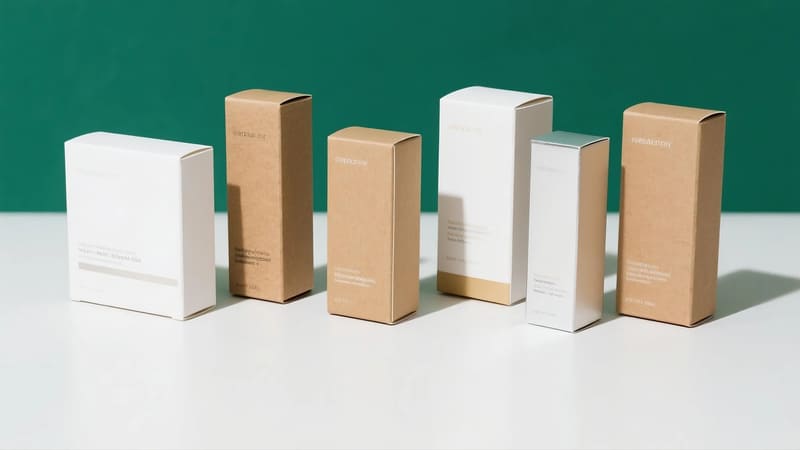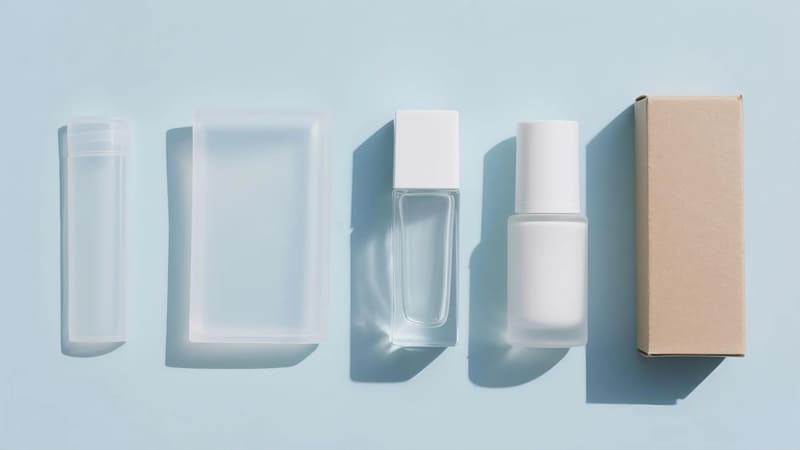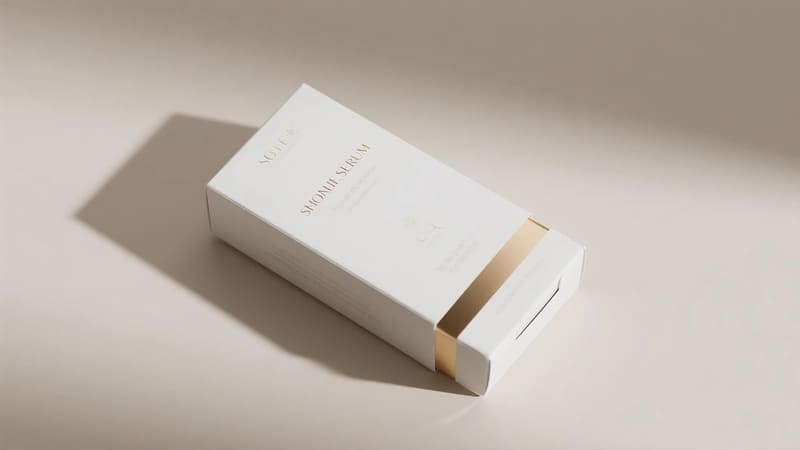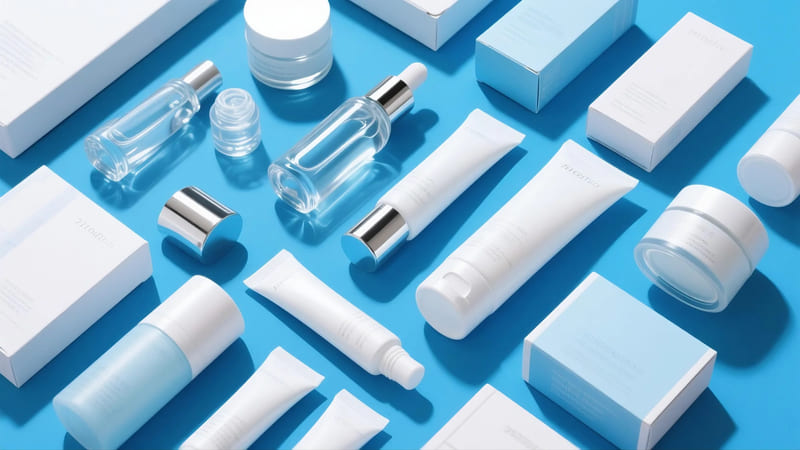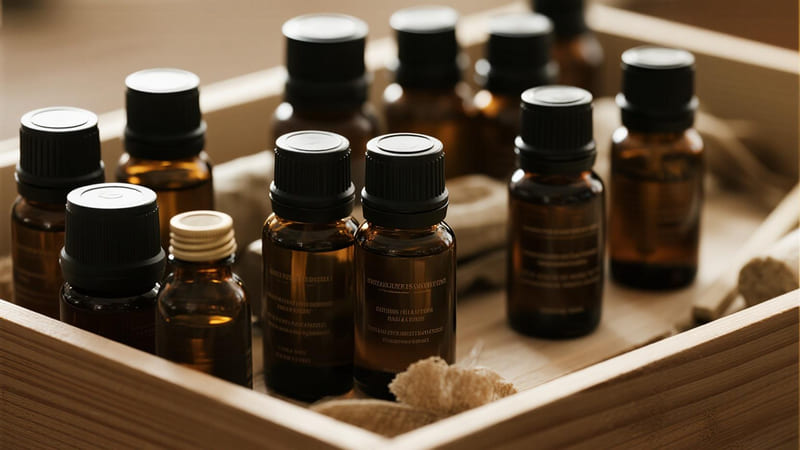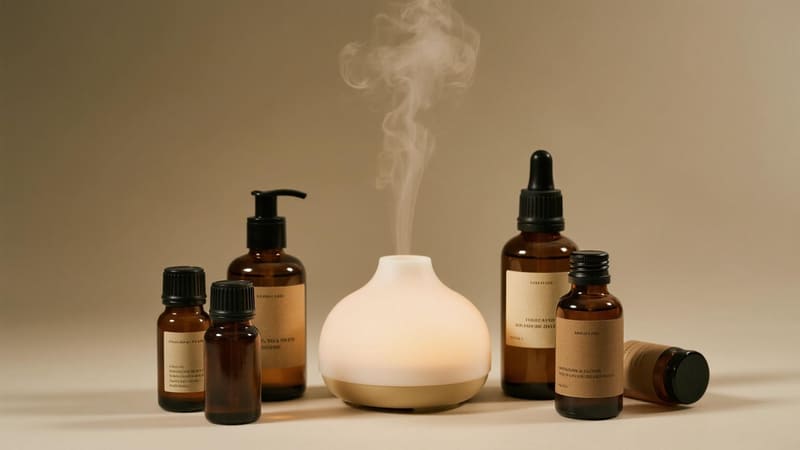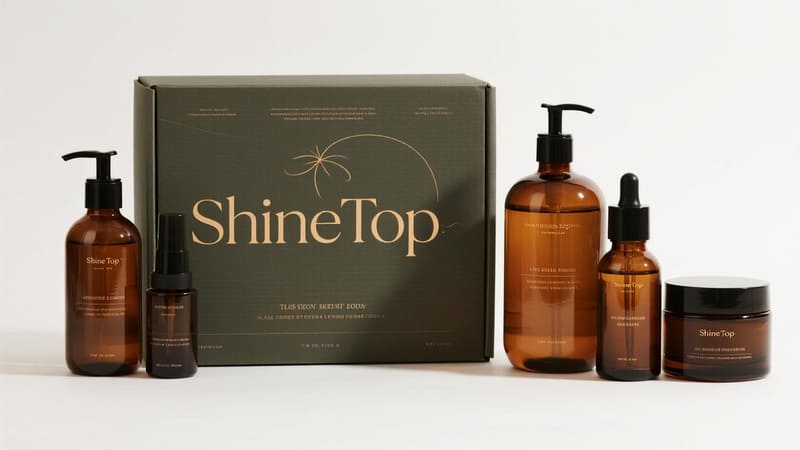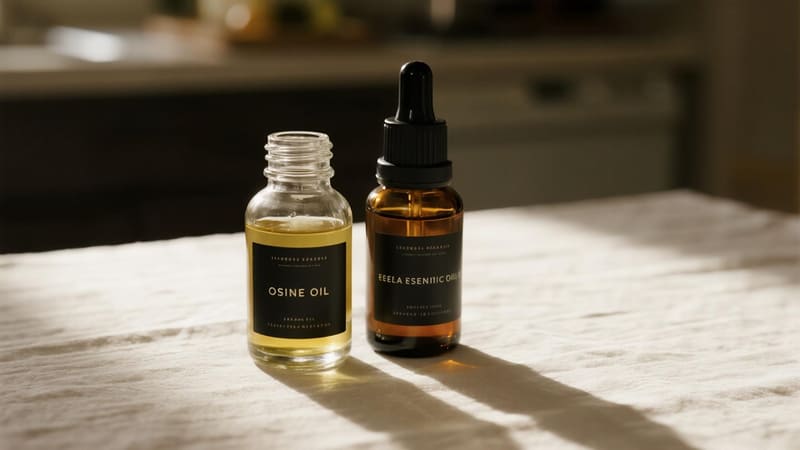Your serum, with its potent ingredients and promise of radiant skin, deserves a box that not only protects it but also reflects its quality and your brand’s essence. Choosing the right material for that box is a key decision.
The best packaging material for serum boxes is typically high-quality paperboard, such as SBS (Solid Bleached Sulfate) for excellent printability and a clean look, or recycled paperboard for an eco-conscious appeal. For luxury serums, rigid board construction offers a premium, gift-like experience. The choice depends on brand positioning, budget, and design goals.
Serums are often high-value products with delicate formulations, so their secondary packaging (the box) plays a crucial role in protection, branding, and conveying quality. As a packaging manufacturer with ShineTop for over 20 years, I’ve guided countless brands in selecting the ideal materials for their specific needs. Let’s explore the best options for your serum boxes.
What is the Best Material for Cosmetic Packaging?
Before zeroing in on serum boxes, it’s useful to understand the broader landscape of materials used for cosmetic packaging. This provides context for why certain materials are favored for specific applications.
There’s no single "best" material for all cosmetic packaging; the ideal choice depends on product compatibility, brand aesthetics, cost, functionality, and sustainability goals. Common materials include plastics (PET, PP, PE), glass, metal (aluminum, tin), and paper/paperboard, each suited to different needs.
The "best" material is always a strategic choice, balancing various factors to meet the product’s and brand’s requirements.
Common Cosmetic Packaging Materials & Their Uses:
-
Plastics (PET, PP, HDPE, LDPE, Acrylic/PMMA, etc.):
- Pros: Lightweight, versatile, shatter-resistant, cost-effective.
- Uses: Bottles, jars, tubes, caps, compacts, airless pumps (often for primary packaging).
- For Serum Boxes: Not typically used for the box itself, but plastic components like windows or inserts might be.
-
Glass:
- Pros: Premium feel, inert (doesn’t react with product), excellent barrier, recyclable.
- Uses: Bottles and jars for luxury creams, serums (primary container), fragrances, nail polish.
- For Serum Boxes: The box protects the glass serum bottle.
-
Metal (Aluminum, Tinplate):
- Pros: Durable, excellent barrier, distinctive aesthetic, recyclable.
- Uses: Tins for balms, aluminum tubes for creams, aerosol cans, caps, decorative elements.
- For Serum Boxes: Metal accents (like foil stamping) are common on boxes, but the box itself is rarely all metal.
-
Paper & Paperboard:
- Pros: Lightweight, printable, versatile for structural design (boxes), recyclable, can be eco-friendly if sourced well.
- Uses: This is the primary material for cosmetic boxes (secondary packaging), labels, inserts.
- For Serum Boxes: This is the star player. Different types of paperboard offer various qualities.
Given that serum boxes are secondary packaging, paper and paperboard are overwhelmingly the best and most common material category. The specific type of paperboard is where the key decision lies for serum boxes.
What is the Most Ideal Packaging Material?
The "most ideal" packaging material is one that perfectly fulfills all functional requirements (protection, containment), aligns with brand values and aesthetics, meets consumer expectations, is cost-effective, and minimizes environmental impact. This is a high bar and often involves trade-offs.
For serum boxes, the most ideal packaging material often balances premium presentation with practicality. High-quality paperboards like SBS (Solid Bleached Sulfate) offer a smooth, bright white surface ideal for printing vibrant graphics and luxury finishes. For brands prioritizing sustainability, FSC-certified or recycled content paperboards are excellent choices. Rigid board offers the most luxurious feel.
When considering the "ideal" material for your serum box, think about these key attributes:
Attributes of Ideal Serum Box Material:
-
Printability & Finish Compatibility:
- The material should provide an excellent surface for high-quality printing (offset or digital) to showcase your branding, product information, and any imagery.
- It must also be compatible with desired finishes like lamination (matte, gloss, soft-touch), foil stamping, embossing, or spot UV.
- Ideal Choices: SBS paperboard is renowned for its printability. Coated recycled boards also offer good surfaces.
-
Structural Integrity & Protection:
- The material must be sturdy enough to protect the often-delicate primary serum container (usually a glass bottle with a dropper or pump) during shipping, handling, and on the retail shelf.
- It should maintain its shape and not crush easily.
- Ideal Choices: Paperboard with appropriate thickness (grammage/caliper). For ultimate protection and a premium feel, rigid board (used in set-up boxes) is superior.
-
Aesthetic Appeal & Brand Alignment:
- The material itself should contribute to the desired brand perception.
- Luxury: Thick, smooth paperboard or rigid board with specialty paper wraps.
- Natural/Eco-conscious: Uncoated recycled board, Kraft paperboard, or paperboard with visible fibers.
- Clinical/Professional: Clean, bright white SBS.
-
Sustainability:
- Consider materials with high recycled content, FSC (Forest Stewardship Council) certification (ensuring responsible sourcing), or those that are easily recyclable.
- Avoid laminations or coatings that hinder recyclability if sustainability is a top priority.
-
Cost-Effectiveness:
- The material cost should align with your product’s price point and overall budget.
- Rigid boxes are more expensive than folding cartons.
For most serum brands, a high-quality folding carton made from SBS or a good recycled board offers the best balance of these attributes. For ultra-luxury positioning, a rigid box is the way to go. At ShineTop, we provide all these options and can guide you to the ideal choice based on your specific serum and brand.
What are the Packaging Options for Skincare?
Skincare packaging is incredibly diverse, reflecting the wide array of product types, formulations, and brand positionings. Serum boxes are just one piece of this larger puzzle.
Packaging options for skincare are extensive, including: Primary containers like airless pumps, glass/plastic bottles (with pumps, droppers, sprayers), jars, tubes, and single-use sachets/ampoules. Secondary packaging commonly includes folding cartons (boxes) or rigid boxes, often with inserts. Labels and leaflets provide information.
Understanding the broader options helps situate where your serum box fits in and how it complements the primary packaging.
Common Skincare Packaging Options:
-
Primary Packaging (Direct Product Contact):
- Bottles:
- Glass: Often for serums, facial oils, toners (premium, inert, protective). Amber/cobalt for light-sensitive formulas.
- Plastic (PET, PP, HDPE): For cleansers, toners, lotions (lightweight, shatter-resistant).
- Dispensers: Pumps, droppers, sprayers, disc-top caps, screw caps.
- Jars:
- Glass: For creams, masks, balms (premium, inert).
- Plastic (PP, PET, SAN, Acrylic): For creams, masks, scrubs (versatile, cost-effective).
- Tubes:
- Plastic (PE, PP) or Laminate (ABL/PBL): For gels, cleansers, spot treatments, eye creams, sunscreens (hygienic, good for controlled dispensing).
- Airless Systems (Pumps, Jars):
- For sensitive formulations (antioxidants, retinoids) to protect from air and contamination, ensuring precise dosing and minimizing waste. Ideal for many serums.
- Ampoules/Vials (Glass or Plastic):
- Single-dose or concentrated treatments.
- Sachets/Pouches:
- Single-use samples, sheet masks.
- Bottles:
-
Secondary Packaging (Outer Packaging):
- Folding Cartons (Boxes): The most common secondary packaging for individual skincare items like serums, creams, and cleansers. Made from paperboard. This is where your "serum box" fits.
- Rigid Boxes (Set-Up Boxes): For luxury skincare items, gift sets, or special editions. Offer a very premium unboxing experience.
- Sleeves: Paperboard sleeves that slide over a primary container or a simpler box.
- Inserts/Platforms: Custom-designed components within a box to hold the primary container securely and present it attractively.
-
Labels & Leaflets:
- Provide branding and essential product information.
For serums specifically, the primary packaging is often a glass dropper bottle or an airless pump bottle. The serum box then serves to protect this primary container, provide ample space for branding and information, and enhance its shelf presence and perceived value.
Anna, a cosmetics manufacturer in Thailand, uses our amber glass dropper bottles for her potent botanical serums. We then produce elegant folding cartons for her from FSC-certified paperboard, printed with soy-based inks, to complete the natural and premium presentation.
What is the Best Material for Packaging?
This is a broad question, as the "best" material is always context-dependent, varying hugely across industries and product types. There’s no universal "best."
The "best" material for packaging depends entirely on the specific product’s requirements (protection, compatibility, shelf life), brand positioning, cost considerations, sustainability goals, and logistical needs. Common contenders for "best" in their respective categories include glass for inertness and premium feel, certain plastics for versatility and cost-effectiveness, aluminum for barrier properties, and paper/paperboard for printability and eco-friendliness (when sourced well).
Instead of a single "best," it’s more accurate to think of the "most suitable" material for a given application.
Factors Determining the "Best" Material for Any Packaging:
-
Product Protection:
- Does it need a barrier against oxygen, moisture, light, odor?
- Does it need physical protection from impact or compression?
- Is it chemically reactive? (Requires an inert material).
-
Product Type & Form:
- Liquid, solid, powder, gas?
- Viscosity, fragility, temperature sensitivity?
-
Brand Image & Market Position:
- Luxury, mass-market, eco-conscious? The material should align.
-
Cost & Budget:
- Material costs, manufacturing costs, and shipping costs all play a role.
-
Sustainability & Environmental Impact:
- Recyclability, recycled content, biodegradability, carbon footprint of production.
-
Regulatory Requirements:
- Food-grade, pharmaceutical-grade, child-resistant features.
-
Consumer Convenience & User Experience:
- Ease of opening, dispensing, resealing, portability.
For Serum Boxes (Secondary Packaging):
Given these factors, high-quality paperboard (like SBS, CUK, or recycled grades) emerges as the "best" all-around material category for most serum boxes because:
- Excellent Printability: Allows for vibrant branding and clear information.
- Good Structural Integrity: Protects the primary serum bottle.
- Versatility in Finishes: Can be laminated, foiled, embossed, etc., to achieve various aesthetics from clinical to luxury.
- Cost-Effective: Generally more affordable than rigid boxes for high volumes.
- Relatively Lightweight: Compared to making the entire outer pack from glass or metal.
- Good Sustainability Profile: If sourced from FSC-certified or recycled content and designed for recyclability.
For ultra-premium serums where cost is less of a concern and a very luxurious unboxing is desired, rigid board (for set-up boxes) would be considered "best."
At ShineTop, our expertise lies in helping brands navigate these material choices. We offer a wide range of paperboard options and the full spectrum of printing and finishing techniques to create serum boxes that are not just containers, but compelling brand statements.
Conclusion
The best packaging material for your serum boxes is typically a high-quality paperboard, chosen to match your brand’s aesthetic, protection needs, and budget. Whether it’s the clean printability of SBS, the eco-credentials of recycled board, or the sheer luxury of a rigid box, the right material will ensure your serum is presented beautifully, protected effectively, and stands out on the shelf.

